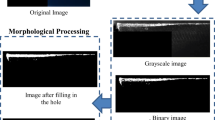Abstract
The objective of this paper is to construct an intelligent sensor fusion monitoring system for tool breakage on a machining centre. Since none of the sensing and diagnosis techniques have proved to be completely reliable in practice, an intelligent tool-monitoring system consisting of a neural-network-based algorithm and a sensor fusion system is proposed. The dual sensing signals of cutting force and acoustic emission are used simultaneously in the proposed system owing to good correlation existing between them, and, a self-learning neural-network algorithm is used to integrate multiple sensing information to make a proper decision about tool condition. The results show good performance in tool-breakage detection by the proposed monitoring system, especially where there is high interference.
Similar content being viewed by others
References
H. K. Tönshoff et al., “Developments and trends in monitoring and control of machining processes”,Annals CIRP,37(2), pp. 611–621, 1988.
A. G. Ulsoy and Y. Koren, “Control of machining processes”,Journal of Systems Measurement and Control,115, pp. 301–308, 1993.
J. Tlusty and G. C. Andrews, “A critical review of sensors for unmanned machining”,Annals CIRP,32, pp. 563–572, February 1983.
K. N. Lou and C. F. Wu, “On the study of the multilayer neural network and Kalman filtering for system identification”,ASME Winter Annual Meeting,DSC-55(1), pp. 547–562, 1994.
M. Shiraishi, “Scope of in-process measurement, monitoring and control techniques in machining processes Part. 1. In-process techniques for tools”,Precision Engineering,10(4), pp. 179–189, 1988.
N. H. Cook and K. Subramanian, “Sensing of drill wear and prediction of drill life”,Trans. ASME, D,99(2), pp. 295ff, 1977.
M. Martelotti, “Analysis of the milling process”,Trans. ASME,63, pp. 667ff, and67, pp. 233ff, 1941.
I. Yellowley, “Observations of the mean values of forces, torques and specific power in the peripheral milling process”,International Journal of Machine Tool Design and Research,25(4), pp. 337–346, 1985.
E. Kannatey-Asibu and D. A. Dornfeld, “Quantitative relationships for acoustic emission from orthogonal metal cutting”,Journal of Engineering for Industry,103, pp. 330–340, 1981.
K. Iwata and T. Moriwaki, “An application of acoustic emission measurement to in-process sensing of tool wear”,Annals CIRP,26, pp. 21–26, 1977.
E. N. Diei and D. A. Dornfeld, “A model of tool fracture generated acoustic emission during machining”,Journal of Engineering for Industry,109, pp. 227–233, 1987.
I. Inasaki and S. Yonetsu, “In-process detection of cutting tool damage by acoustic emission measurement”,Proceedings 22nd International Machine Tool Design and Research Conference, pp. 261–268, 1981.
J. B. Liu, “Monitoring the precision machining process: sensors, signal processing and information analysis”, PhD dissertation, ME, University of California at Berkeley, 1991.
J. A. Freeman and D. M. Skapura,Neural Networks: Algorithm, Applications and Programming Techniques, Addison-Wesley, 1992.
R. E. Kalman, “A new approach to linear filtering and prediction problems”,Journal of Basic Engineering Trans. ASME, D,82(1), pp. 35–45, 1960.
R. Ippolito, G. F. Micheletti and R. Vilenchich, “Experimental analysis of the correlation between cutting forces variation with time and cutting data”,Proceedings 14th MTDR Conference, pp. 741–745, 1973.
J. Roget, P. Souquet and N. Gsib, “Use of acoustic emission for in-process monitoring of tool during turning and milling”,Progress in Acoustic Emission 3, the Japanese Society of NDI, pp. 94–101, 1986.
M. S. Lan and D. A. Dornfeld, “In-process tool fracture detection”,ASME Journal of Engineering Materials and Technology,106, pp. 111–118, 1984.
T. I. Liu and K. S. Anantharaman, “On-line sensing of drill wear using neural network approach”,IEEE International Conference on Neural Networks,2, pp. 690–694, 1993.
Author information
Authors and Affiliations
Rights and permissions
About this article
Cite this article
Lou, KN., Lin, CJ. An intelligent sensor fusion system for tool monitoring on a machining centre. Int J Adv Manuf Technol 13, 556–565 (1997). https://doi.org/10.1007/BF01176299
Issue Date:
DOI: https://doi.org/10.1007/BF01176299




